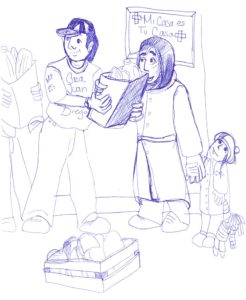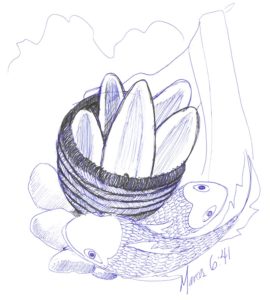The guests living in our Casa Juan Diego Houses of Hospitality, along with the Workers who live and work there, eat the same food, together. Our meals are simple, nourishing, and lovely at times. Feeding and serving food happens all the time at Casa Juan Diego as an act of generosity and love. Food, however, has been important to the development and history of Casa Juan Diego, and to the entire Catholic Worker Movement.
I recently attended the inaugural Peter Maurin Conference in Chicago. Peter was the “Theologian” and “Philosopher” while Dorothy Day was the “Worker,” starting the first Catholic Worker House of Hospitality in Manhattan in 1933, offering food first, then clothing and hospitality to those devastated by the Great Depression. The movement has spread worldwide, and according to the Wikipedia article “Catholic Worker Movement” (a must read!), “the movement claims over 240 local Catholic Worker communities providing social services. Each house has a different mission, going about the work of social justice in its own way, suited to its local region.”
I guess I knew that intellectually, but in talking with Catholic Workers from all over the country, I understood for the first time how diverse the different communities are. Some, like Casa Juan Diego, are very Catholic, others are more secular. Some concentrate on the guests living in their Houses of Hospitality, others, like Casa Juan Diego, are also very much involved with the surrounding community. And I was surprised by the fact that many Catholic Worker communities, particularly ones started recently, do not have a house at all!
So, what is the common denominator of all these very different Catholic Worker communities? I think that what they have in common, and the only thing they have in common, is a dedication to one or more of the corporal Works of Mercy: feeding the hungry, giving drink to the thirsty, sheltering the homeless, visiting the sick, visiting the prisoners, burying the dead, and giving alms to the poor. Peter Maurin and Dorothy Day remind us that we cannot love Christ without loving our neighbor, and loving them not in theory, but concretely, loving them in their bodily needs.
The focus of Casa Juan Diego at its founding in 1980 was at first on sheltering the homeless, specifically the homeless refugees from the genocidal civil war in El Salvador. The Houston House was modeled in many ways on Mary House, which Dorothy Day started almost fifty years previously – a House of Hospitality where guests and Workers lived together in community, with the Workers taking no salary and the House accepting no money from the government. All work relying solely on the generosity of donors and the grace of God. Getting the homeless off the streets in our part of Houston was a priority in the early days, but the importance of feeding the hungry who remained on the street was an obvious need, too. Mark Zwick, our co-founder, turned outward to the surrounding refuge community first by starting a food distribution to our hungry neighbors. He would drive a van, and later a large truck (today people know it as the Guadalupe truck) to Reyes Produce and then later to the Food Bank each week. Volunteers at Casa Juan Diego helped distribute the food. Mark firmly believed that the two pounds of rice and two pounds of beans we gave out to every adult was vital not only because people were hungry, but also because it supported and affirmed the culture of the many new immigrants arriving at the time.
As early as the May 1982 edition of the Houston Catholic Worker newspaper, Mark described the food given in the early years: “We feed many families by putting soup in their kitchens. With a bag of groceries costing less than $10.00 we can feed a family of 6 for a number of days. Basic foods are provided: 5 pounds of wheat flour, 2 pounds of rice, 2 pounds of pinto beans, 5 pounds of masa harina (corn flour), oatmeal, powdered milk, shortening. At times we add peanut butter, tuna, bread, and donated goods. Thus, with several hundred dollars and donated goods we can feed many families for a long period. However, people have to be really hungry to appreciate this diet. The majority of people who come for food at Casa Juan Diego come only once or twice. We do provide long-term support to several people who are blind, crippled or incapacitated in some way, who can’t receive assistance from any agency because their papers are not in order. The traditional soup kitchen clientele, young and old transients, alcoholics, former ‘institutionalized persons’ and elderly do come to Casa Juan Diego and are served.”
Although the beginnings were small, today Casa Juan Diego is a major source of nutrition and food security for our community. Before Hurricane Harvey, the largest rainfall event in US history, we were serving about 300 families each week through our food distribution. I knew almost all of them! As people passed through for food we had conversations about health, family, and life events, and along with a dedicated group of volunteers, we not only fed people, we developed a Tuesday morning despensa community.
After Harvey, that all changed. When we were able to restart our distribution, the numbers of participants had more than doubled. I frequently tell people that the low-income and undocumented immigrant community of Houston never really recovered from Harvey. The people doing much of the recovery work never were able to recover themselves. Their apartments or houses were not restored, their loss of work was never made up, their savings were not replaced. Those without papers do not qualify for federal benefits, so they took the losses and kept on working to rebuild the city, even though unscrupulous contractors often paid less than the minimum wage or paid not at all.
And then, there was the pandemic.
The ensuing crashing of the economy, which hit the immigrant and low-income communities the hardest, increased both hunger and the anxiety of not knowing if you could feed your family. Our weekly food distribution went from 600 families a week to nearly 1,200 families, where it stands today. Sometimes I am in awe at the miracle of the Catholic Worker model, that we can continue this volume of work and care for the community without paid staff. As was the case with Hurricane Harvey, after most Houstonians have recovered from the pandemic, our neighbors have not. Requests for food and rent assistance continues to rise. And while we can no longer provide groceries to a family of six for ten dollars, thanks to our generous donors we are keeping up with the increased cost of feeding the increased numbers, but just barely.
The Christmas holidays are always our busiest time of the year. More people will need food, and people in general seem drawn to our mission and our work like no other time. These Works of Mercy, especially feeding the hungry, are compelling to the human heart, and the Christmas story, a story of migration – an unsheltered and very pregnant mother far from home, hungry, afraid – is more relevant today than ever. The reasons that she and others like her fled, in desperate need of safety, shelter, and care, may have changed over the centuries, but Mary, as a universal symbol of those who must rely on the hospitality of strangers, is ever present at our door.
Houston Catholic Worker, October-December 2024, Vol. XLIV, No. 4



